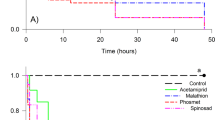Abstract
Fipronil is an insecticide widely used to control a great number of pests, thus the aim of this study was to determine the lethal dose and lethal concentration (LD50 and LC50) of this insecticide to the stingless bees Scaptotrigona postica Latreille, 1807. The LD50 and LC50 values obtained after 24 h of exposition were of 0.54 ng a.i./bee and 0.24 ng a.i./μL diet, respectively. These values were considered highly toxic to stingless bees.


Similar content being viewed by others
References
Aliouane Y, Hassani AKE, Gary V, Armengaud C, Lambin M, Gauthier M (2009) Subchonic exposure of honeybees to sublethal doses of pesticides: effects on behavior. Environ Toxicol Chem 28:113–122
Bernal J, Martin-Hernandez R, Diego JC, Nozal MJ, Gonzalez-Porto AV, Bernal JL, Higes M (2011) An exposure study to assess the potential impact of fipronil in treated sunflower seeds on honey bee colony losses in Spain. Pest Manag Sci 67:1320–1331
Brittain CA, Vighi M, Bommarco R, Settele J, Potts SG (2010) Impacts of a pesticide on pollinator species richness at different spatial scales. Basic Appl Ecol 11:106–115
Caboni P, Sammelson RE, Casida JE (2003) Phenylpyrazole insecticide photochemistry, metabolism, and GABAergic action: ethiprole compared with fipronil. J Agric Food Chem 51:7055–7061
Carvalho SM, Carvalho GA, Carvalho CF, Bueno Filho JSS, Baptista APM (2009) Toxicidade de acaricidas/inseticidas empregados na citricultura para abelha africanizada Apis mellifera L. 1758 (Hymenoptera: Apidae). Arq Inst Biol 76:597–606
Cluzeau S (2002) Risk assessment of plant protection products on honey bees: regulatory aspects. In: Devillers J, Pham-Delègue MH (eds) Honey bees: Estimating the environmental impact of chemicals. Taylor & Francis, London, pp 42–55
Decourtye A, Devillers J, Genecque E, Le Menach K, Budzinski H, Cluzeau S, Pham-Delègue M (2005) Comparative sublethal toxicity of nine pesticides on olfactory learning performances of the honeybee Apis mellifera. Archiv Environ Contam Toxicol 48:242–250
Decourtye A, Lefort S, Devillers J, Gauthier M, Aupinel P, Tisseur M (2009) Sublethal effects of fipronil on the ability of honeybees (Apis mellifera L.) to orientate in a complex maze. Julius-Kühn-Archiv 423:75–83
Devillers J (2002) The ecological importance of honey bees and their relevance to ecotoxicology. In: Devillers J, Pham-Delègue MH (eds) Honey Bees Estimating the Environmental Impact of Chemicals. Taylor & Francis, London, pp 1–332
El Hassani AKE, Dacher M, Gauthier M, Armengaud C (2005) Effects of sublethal doses of fipronil on the behavior of the honeybee (Apis mellifera). Pharmacol Biochem Behav 82:30–39
Ferreira RAC, Silva-Zacarin EMC, Tomotake MEM, Malaspina O (2012) (No prelo) Cellular responses in the Malpighian tubules of Scaptotrigona postica (Latreille, 1807) exposed to low doses of fipronil and boric acid. Micron, in press
Hainzl D, Casida JE (1996) Fipronil insecticide: novel photochemical desulfinylation with retention of neurotoxicity. PNAS 93:12764–12767
Imperatriz-Fonseca VL (2010) Polinização: Os desafios de um Brasil biodiverso para o uso dos serviços ambientais prestados pelas abelhas. In: Ribeiro MF (ed), Segunda Semana dos polinizadores. (pp. 49–59). Petrolina: Embrapa Semiárido-Documentos, p 229.
Ishaaya I (2001) Biochemical processes related to insecticide action: an overview. In: Ishaaya I (ed) Biochemical sites of insecticide action and resistance. Springer, Berlin, pp 1–10
Lourenço CT, Carvalho SM, Malaspina O, Nocelli RCF (2012) Oral toxicity of fipronil insecticide against the stingless bee Melipona scutelaris (Latreilli, 1811). Bull Environ Contam Toxicol 89:921–924
Macieira OJD, Proni EA (2004) Capacidade de resistência a altas e baixas temperaturas em operárias de Scaptotrigona postica (Latreille) (Hymenoptera, Apidae) durante os períodos de verão e inverno. Rev Bras Zool 21:893–896
Mayer DF, Lunden JD (1999) Field and laboratory tests of the effects of fipronil on adult female bees of Apis mellifera, Megachile rotundata and Nomia melanderi. J Apic Res 38:191–197
Moraes SS, Bautista ARL, Viana BF (2000) Avaliação da toxicidade aguda (DL50 e CL50) de inseticidas para Scaptotrigona tubiba (Smith) (Hymenoptera: Apidae): via de contato. An Soc Entomol Brasil 29:32–37
Organization for Economic Cooperation and Development (OECD) (1998a) Honeybees, acute contact toxicity test. OECD guidelines for the testing of chemicals, p 214
Organization for Economic Cooperation and Development (OECD) (1998b) Honeybees, acute oral toxicity test. OECD guidelines for the testing of chemicals, p 213
Pinheiro JN, Freitas BM (2010) Efeitos dos pesticidas agrícolas sobre polinizadores e perspectivas de manejo para os agroecossistemas brasileiros. Oecol Aust 14:266–281
Ritz C, Streibig JC (2005) Bioassay analysis using R. J Stat Softw 12:1–22
Roessink I, Steen JVD, Kasina M, Gikungu M, Nocelli RCF (2011) Is the European honeybee (Apis mellifera mellifera) a good representative for other pollinators species? In: SETAC Europe annual meeting, 21 May 2011, Milan, pp 3–35
Rortais A, Arnold G, Halm MP, Touffet-Briens F (2005) Modes of honeybees exposure to systemic insecticides: estimated amounts of contaminated pollen and nectar consumed by different categories of bees. Apidologie 36:71–83
Stanley J, Chandrasekaran S, Preetha G, Kuttalam S (2010) Toxicity of diafenthiuron to honey bees in laboratory, semi-field and field conditions. Pest Manag Sci 66:505–510
R Development Core Team (2012) R: A language and environment for statistical computing. R Foundation for Statistical Computing, Vienna, Austria. ISBN 3-900051-07-0. http://www.R-project.org/. Accessed 20 June 2012
Tingle CC, Rother JA, Dewhurst CF, Lauer S, King WJ (2003) Fipronil environmental fate, ecotoxicology and human health concerns. Rev Environ Contam Toxicol 176:1–66
Acknowledgments
This study was supported by the Fundação de Amparo a Pesquisa do Estado de São Paulo/FAPESP, Brazil (grants 2010/03723-5).
Author information
Authors and Affiliations
Corresponding author
Rights and permissions
About this article
Cite this article
Jacob, C.R.O., Soares, H.M., Carvalho, S.M. et al. Acute Toxicity of Fipronil to the Stingless Bee Scaptotrigona postica Latreille. Bull Environ Contam Toxicol 90, 69–72 (2013). https://doi.org/10.1007/s00128-012-0892-4
Received:
Accepted:
Published:
Issue Date:
DOI: https://doi.org/10.1007/s00128-012-0892-4




